How did Sam Walton go from throwing newspapers as a teenager to being the richest man in the world?
In this book Made in America, Sam Walton shares the story of how he did it. This is the autobiography of the Walmart’s founder. He started with one small store in one small town in the middle of the United States. And he grew that into one of the largest businesses ever—Walmart.
If you’re interested in business and entrepreneurship, then you’re about to discover many helpful lessons to guide your own journey. Sam Walton’s story will be inspirational to anybody who wants to succeed in free enterprise. And to anybody willing to work hard to achieve the American Dream (or the dream in whichever country you’re in).
Who was Sam Walton?
Sam Walton (Walmart.com) founded Walmart in 1962. Today, Walmart continues to be one of the biggest companies with around 11,000 stores, 2.2 million employees and $540 billion sales revenue. When he wrote this book, Walton was sick with cancer and wanted to finally share exactly what happened from start to finish. The Walton family still owns about 50% of Walmart shares.
So let’s begin this summary with the first great lesson…
💵 1. The Frugal Billionaire: Spend money very carefully
After Walmart became successful, Sam Walton was named the world’s richest person by Forbes magazine. Reporters came to see him and they were fascinated to discover Sam still lived a basically normal life in his small town.
If you walked by Sam in the street, you probably wouldn’t think he was a millionaire, let alone a billionaire! He bought his clothes at Walmart, cut his hair at the local barbershop like everyone else and he drove around in an old pickup truck.
You see, Sam Walton grew up during the Great Depression and his parents taught him not to spend money foolishly. He didn’t grow up poor, but his parents worked hard at regular jobs. So even as Sam became more successful, he continued to avoid luxury and unnecessary spending.
Later on, frugality became a core value at Walmart and a key part of their success:
- Lower expenses allowed Walmart to charge lower prices.
- Lower prices brought in more customers.
- Lower expenses also gave Walmart more room for mistakes.
Many of their competitors were run by people looking to get rich to have a flashy lifestyle. Those people eventually lost focus and stopped improving their stores. As a result, Walmart beat them all. Sam Walton worked hard to make frugality a shared value at Walmart. If a Walmart executive was flashing their wealth too much, Sam would publicly criticize them. He believed that was a big distraction and they should always be focusing on serving the customer better.
The bestselling business author Simon Sinek says that all extraordinary companies start with a powerful why. A strong mission behind what they do unites their employees in a common direction. Today Walmart says their mission is “saving people money so they can live better.” And the more Walmart can lower their costs, the more they can lower their prices and fulfill this mission.
As a kid, Sam Walton was raised to spend money very carefully. After he became very wealthy, he continued to live a mostly simple life. Later on, keeping expenses low was a key factor in Walmart’s success.
🚀 2. Born With Ambition: Work obsessively towards your goals
From a young age, Sam Walton was gifted with an incredible amount of drive and ambition:
- Grades: He studied hard to make the honor roll in high school,
- Athletics: He won the state championship as quarterback of the football team,
- Politics: He ran for multiple offices in college and was elected president of the student body,
- Finances: He also worked to make his own money throughout school, starting with a newspaper route and later having multiple jobs.
Sam Walton graduated college in 1945 and he began working at JC Penney as a management trainee. This experience got him excited about the retail business and he decided to open his own store. But before he could do that, he served in the US army and got married. He was also reading all the books he could find in the libraries about the retail business.
In 1945, Sam Walton opened his first store in a small town called Newport, Arkansas. It was under the franchise name of Ben Franklin. He was 27 years old at the time and borrowed most of the $25,000 he needed from his father in law.
Sam set big goals for himself. He wanted his little store to be the most profitable one in the area. Then he worked 6 or 7 days per week to achieve his goals. He usually came into the office before 5AM. In fact, he continued starting work this early even after Walmart became a big success. (However, he often did take time off to go hunting, play tennis or go on long summer road trips with his family.)
Basically every highly successful entrepreneur says they worked very very hard. This is not a guarantee that you will be successful, rather it’s the bare minimum. For example, Elon Musk often tells young ambitious people to “work twice as hard as others.” Musk often works 80-100 hours every week.
Sam Walton was always driven, ambitious and hard working. He was a leader in school and worked for his own money. After he opened his first store, he worked 6-7 days per week, starting before 5AM.
🧪 3. Daily Evolution: Keep trying new experiments
As we said, Sam Walton franchised his first store through a company called Ben Franklin. They provided the store branding, systems and training. Ben Franklin taught Sam the basics of running a retail store, but their rules soon began to feel restrictive.
Sam Walton quickly started to experiment with his own business ideas:
- He discovered cheaper suppliers in a different state and brought their merchandise into his store with car trailer that was homemade.
- He tried various attention grabbers to bring people inside his store, including a soft ice cream machine and a popcorn machine.
- He was always trying creative new ways of promoting specific products to increase their sales, including hanging items from the ceiling or putting them in a boat. And he encouraged his store managers to get creative too.
If we fast forward to the future, we see this experimentation continued on a larger scale. Sam’s Club started out as an experiment, it was a membership-based store similar to Costco that had far thinner profit margins than Walmart. It was a big success, so they quickly opened up many more locations of Sam’s Club. On the other hand, some big experiments failed including a chain of discount drug stores and a series of super-large Walmarts called Hypermarts.
Two things about Sam Walton distinguish him from almost everyone else I know. First, he gets up every day bound and determined to improve something. Second, he is less afraid of being wrong than anyone I’ve ever known. And once he sees he’s wrong, he just shakes it off and heads in another direction.
– David Glass, later CEO of Walmart
Today, if you’re an aspiring startup founder, then the book you’ll see recommended most often is The Lean Startup by Eric Ries. That book says the biggest mistake new entrepreneurs make is waiting too long to launch a product. Many people spend years talking about their idea… only to later find out nobody wants it!
Instead, Eric Ries says we must launch a minimum viable product as soon as possible. That’s like the most basic version of your product, software, app or website. Then you will get feedback from your early users in the real world and they will tell you exactly how to improve it to become successful.
I think it is a similar approach to Sam Walton. Sam admits his first stores were not very professional, but it’s clear they gave him a place to experiment and learn how to sell merchandise.
Experimenting and trying new things was always a key part of Sam Walton’s success. In his early days, he tried gimmicks like soft ice cream machines. Later there were much larger experiments like Sam’s Club, a new kind of retail store.
🕵️ 4. Competitive Intelligence: Always be learning from other businesses
A major key to Sam Walton’s success was studying his competition. In Made in America, there are many fascinating quotes from Sam’s family members and work associates. One thing they mention over and over again is how much time Sam spent inside his competitor’s stores. Walton read a lot of books and publications about the retail business, but a large part of his education came from this real world research.
Walton’s first major competitor in that small town was a store owner named John Dunham. Sam was always in Dunham’s store, observing how everything worked. He was trying to find any possible idea that he could borrow for his own business. When Sam and his family went on road trips, Sam would stop to look in almost every store they passed. His family just accepted it was something he had to do for their livelihood.
20 years later, people would still find Walton in his competitor’s stores. He would be seen at Kmart questioning an employee about how they did everything and writing it all down in a little notepad. And he was always telling his managers to do the same thing: check out the competition and find at least one good idea they could try in their own stores.
I have learned to do the same thing in my own business here at growthsummary.com. I’m always looking carefully at other websites and apps. I study their layouts, their marketing, their sales pages, etc. I’m trying to find a new idea that I can borrow to make my business 1% better. One of the best tips I’ve received for digital marketing is to keep a ‘swipe file’ or a collection of impressive things you see online, especially from your competitors.
Sam Walton spend a lot of time in his competitor’s stores. He was always studying what other businesses were doing, talking to their employees and taking notes. He wanted to find good ideas and borrow them for his own business.
🔭 5. Looking Ahead: Forget the past and focus on future goals
Sam Walton’s first store did incredibly well. The previous owner of the store had sales of $72,000 per year. Within a couple of years, Sam doubled those sales. And within 5 years he grew the sales to over $250,000 per year. It was one of the most successful variety stores in Arkansas. He paid off all his loans and was feeling great.
Then something really bad happened. After 5 years, Walton was kicked out of his own store building because he hadn’t read the fine print on the lease carefully enough. He tried not to obsess about how unfairly he was being treated. Instead, he focused on his future goals. The only thing he could do was start all over again in a new town. So that’s what he did.
At 32 years old, Sam moved with his family to another town called Bentonville and he opened up a new store. And he grew that store to be very successful too. So over the years he opened up more stores in nearby towns. 15 years later in 1960, Sam Walton had opened 15 little stores. Some of these were called “Walton’s Five and Dime.” Driving to visit all the locations was taking too much time, so he began flying between the towns in his small 2-person plane.
Sam grew his first store into a success, but he was kicked out of the building because of a real estate mistake. He was forced to start all over again and he eventually opened over a dozen variety stores.
📈 6. The Next Thing: Notice and adapt to rising trends
Sam was always looking for what was new in the retail industry. He quickly adapted to multiple trends that were rising in America including:
- Self-service stores. In the past, a store employee would find the items you want and bring them to you. Sam heard about the first self-service stores and rode an overnight bus to see them firsthand. Then he opened the 3rd self service store in the USA.
- Discounter stores. In the early 1960’s, a new type of retail store called a discounter store began popping up. The idea was to sell products at cheaper prices, but with a higher volume of sales they still made a lot of profit. Sam Walton saw discounter stores very successful in the northeast US and he knew they would come to Arkansas soon.
So in 1962, Sam Walton opened his first discounter store in a town called Rogers Arkansas. That was the birth of Wal-Mart. The first Wal-Mart was a big hit immediately, with almost a million dollars in sales per year. Sam Walton recognized these stores were the future of retail and he wanted to stay ahead of the trend by opening up more and more Wal-Marts. Some of the other big retail companies resisted the discounter trend, probably because they didn’t want to give up the 45% markup they were used to charging customers.
Small towns were a key part of Walmart’s winning strategy. At that time, most of the big retail companies believed a large discount store could only be successful in bigger cities. Sam Walton went against that conventional wisdom and he opened Walmarts in towns as small as 5,000 people. This turned out to be a great idea. People stopped driving to the big city discount stores and visited their local Walmart instead.
Jeff Bezos is the founder of Amazon.com. He built one of the most valuable companies ever and became the richest man in the world. I see him almost like a modern-day version of Sam Walton. Some people may look at billionaire entrepreneurs like Bezos and Walton and think “they were just in the right place at the right time.”
However, if we look deeper into the story of Bezos, we learn he didn’t stumble across the idea for Amazon.com by accident. As a young man, he was reading many little-known technology newsletters and trying to spot the next big trend. That’s why he understood the internet would be very important before most people had even heard of it. When it comes to business ideas, Bezos has even said, “Never chase the hot thing… you need to position yourself and wait for the wave.”
Learn more in our summary of The Everything Store by Brad Stone
In 1962, Sam Walton adapted to the rising trend of discounter stores by opening the first Wal-Mart and it was an immediate hit. Discounter stores were bigger than traditional variety stores and they had cheaper prices.
🏷️ 7. Low Prices: Overcome competition with a strong singular focus
The first Walmart store had a sign with with their name and two slogans on either side. The slogans were: “We sell for less” and “Satisfaction guaranteed.” Sam Walton says this strong focus on selling for less has made them so successful. He was always determined to keep Walmart’s prices lower than all their competitors:
- He limited Walmart products to a 30% markup, even when they could have charged more for a product.
- He made sure their big competitors like Kmart never sold a product for a lower price than Walmart, not even by a penny.
- He was always looking for way to reduce expenses, through more efficient warehouses and computer-based systems.
Sam wanted people to immediately think of low prices when they thought of Walmart. Everything else was secondary. Sam admits many of their early stores did not look very good, but they always made sure to have the lowest prices. He opened up more and more Walmarts, but he was starting to stress about all the debt he was taking on. So in 1970, they made Walmart a public company by putting it on the stock market. This gave them the capital to unleash Walmart’s incredible growth for the next 20 years.
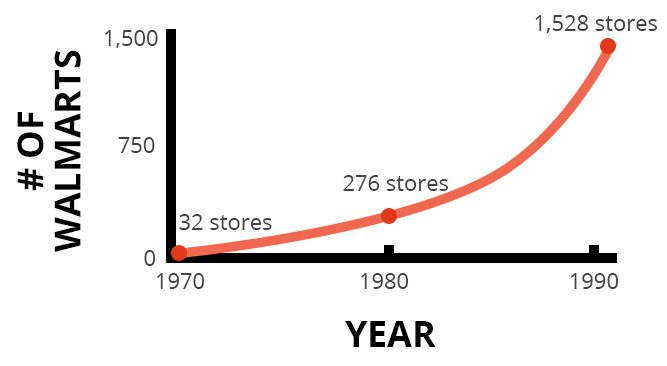
The marketing experts Jack Ries and Al Trout say the most important thing in business is to own a space in your customer’s mind. In other words, people need to strongly associate your brand with some core benefit, like they associate Walmart with “low prices.” They wrote, “The essence of marketing is narrowing the focus. You become stronger when you reduce the scope of your operations. You can’t stand for something if you chase after everything.”
In this book, Walton says other businesses can still compete with Walmart, but not on price. They must choose a specific niche market and serve it extremely well. So if you want to win in business, decide what your strong primary focus will be.
Learn more in our summary of The 22 Immutable Laws of Marketing by Ries & Trout
Walmart outcompeted other retail stores by always having the lowest prices. Everything else was less important than maintaining that strong focus on selling for less.
🤝 8. Shared Ownership: Give your people responsibility and recognition
Obviously, Sam Walton could not build Walmart alone. He did it with the cooperation of dozens of important executives, thousands of managers and millions of employees. The question is: How could he encourage them care about Walmart’s success as much as he did? Here are a few ways:
- Shared ownership. Early Walmart store managers always owned a small percentage of their stores. So the more successful the store became, the more they personally benefitted.
- Executive compensation. Walmart executives are rewarded more based on how the company performs. If Walmart doesn’t grow, they make a lot less income.
- Profit sharing. Walmart now has programs which help their everyday employees earn stock as a job benefit. Some employees who have worked at Walmart for decades have accumulated hundreds of thousands of dollars. Benefits like this also help them avoid unionization.
- Employee recognition. Every Saturday at 7:30AM in Walmart’s headquarters, there’s a big meeting in an auditorium. Hundreds of Walmart executives, managers and employees gather to share what’s working in stores around the country. It’s also used as a time to recognize people for their good work or good ideas.
Sam Walton encourages his people to care about Walmart by sharing the success. Early store managers, company executives and even regular employees are rewarded when Walmart does well.
Conclusion
At the end of this book, Sam Walton is very sick with cancer and he’s reflecting on his life. Would he do anything differently? Not really. He believes that he played an important role in the world and provided a valuable service to many people. Those of us who shop at Walmart have collectively saved billions of dollars because of the lower prices.
My favorite part of this biography was to see how much Sam Walton was always learning, experimenting and adapting to competition. I think that lesson is incredibly valuable to any of us who are in business.






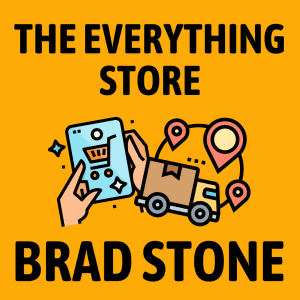
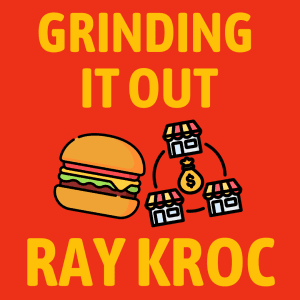
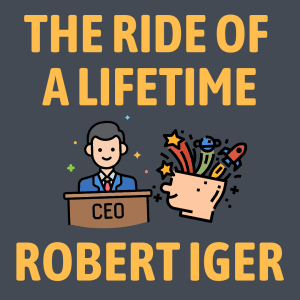


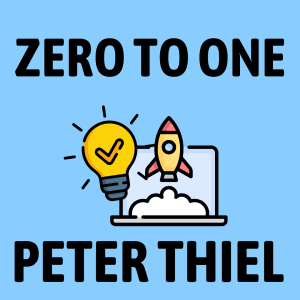

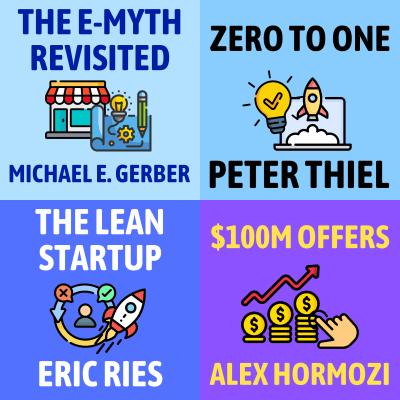
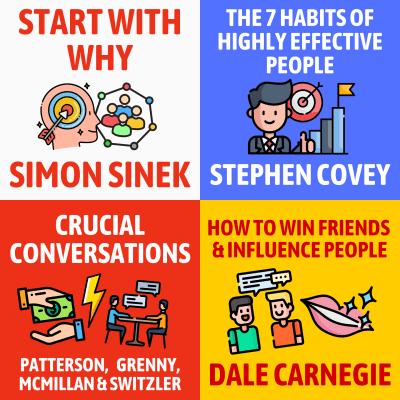

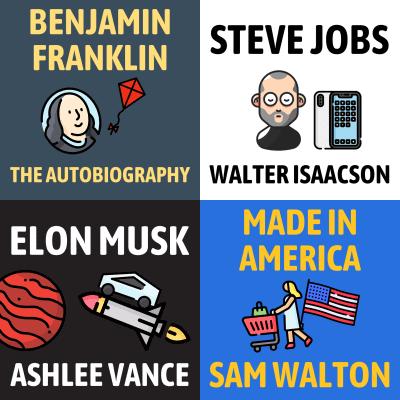
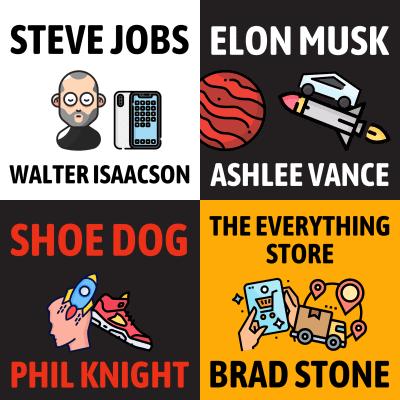
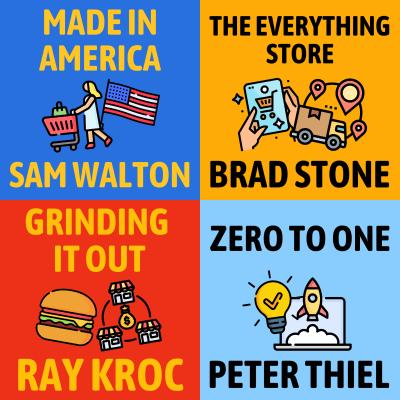












Community Notes